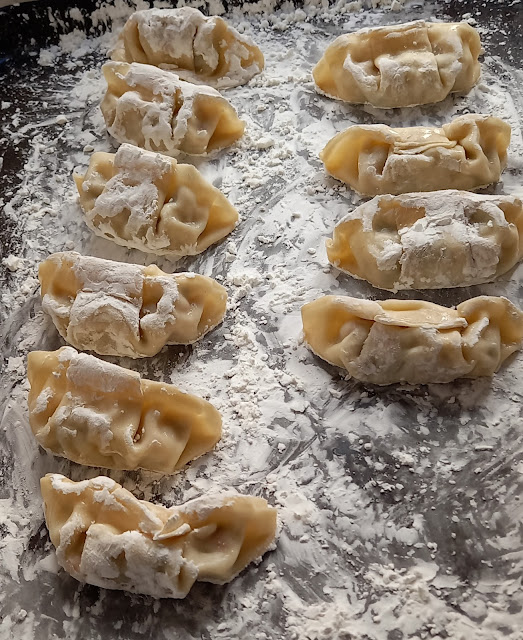Food Sans Frontières
Prompted by a recent post on instagram by Alissa Timoshkina I have been thinking a lot about foods that cross borders.The most obvious one that comes to mind is polenta. It is one of those foods that has no boundaries.Italian yes but also Eastern European ( Ukrainian and Romanian ). It is also a staple in South African cuisine where its served for breakfast with sausages and tomato sauce. Corn meal dishes are staples in Spain and Portugal also. Interestingly though the Andalusian Polea Porridge, was wartime fare, a sort of a breakfast soup, and is a perfect example of a recipe created by the imaginative poor people during the Spanish Civil War. Ingredients were rationed at that time. Polea was made with water, flour, salt, anise, milk and sugar. Nowadays polea is made with celeriac. Xerém or Xarém is an African-Brazilian speciality, traditionally from Portugal but also eaten in Cape Verde and Brazil. It is a porridge made with corn flour combined with traditional ingredients from each region where it is prepared. In the Algarve it is served with cockles.
Polenta aside, if there is one thing that has unversally brought us cooks together cooking for Ukraine its the Varenyky. Pronounced vah-rEH-nee-key, they are Ukrainian stuffed dumplings – often better known by their Polish name, pierogi.Varenyky(vareniki/dumplings) are popular across the globe, and abroad they have other names, shapes, and fillings.
 |
| Traditional Ukrainia savoury Varenyky |
 |
| Sweet filled varenyki with strawberries |
 |
| Russian pelmeni |
Once upon a time there was a meatball... Meatball was very tired... found a blanket, and got comfortable. Really comfortable. So comfortable that Meatball didn’t notice when the blanket started wrapping him up. And thus began the story of how the dumpling was born ( only joking ).
A dumpling is a delicious, bite-sized food that’s made of savoury ingredients wrapped in dough and cooked. … If you order dumplings in a Chinese restaurant, you’ll get a filling made with vegetables, meat, or fish — it might be a wonton, cooked in a soup, or a potsticker, steamed and then lightly fried.
 |
| Chinese xiaolongbao served in a traditional steaming basket |
Shui Jiao. This is most likely the classic dumpling that you’ll get in a Chinese restaurant. …
Potstickers are a type of traditional pan-fried Chinese dumpling. …
Boiled Dumplings are more similar to the dumpings i grew up with in the Uk.
Xiao Long Bao (Soup Dumplings) …
Sheng Jian Bao (Pan-Fried Soup Dumplings) …
Boiled Dumplings are more similar to the dumpings i grew up with in the Uk.
Xiao Long Bao (Soup Dumplings) …
Sheng Jian Bao (Pan-Fried Soup Dumplings) …
Char siu bao ( steamed meat filled buns)
Wontons. …
Har Gow. …
Shumai.
Wontons. …
Har Gow. …
Shumai.
Guo Tie. …
Hun Tun. …
Siu Mai. …
Bao Zi.(pronounced “jow-zee”) are perhaps the most common type of Chinese dumpling. Crescent-shaped and formed with an opaque wrapper made from wheat dough, jiaozi are usually filled with ground pork, cabbage, and scallions, and served with a dipping sauce made of soy sauce, vinegar, and sesame oil.
Bao, for Chinese speakers, includes all things wrapped and bundled, including dumplings, be it baked, fried, fermented or steamed. We don’t have the equivalent for such a glorious food item in Europe. So dumpling is as close as we can get to describing baos, but the word is not nearly inclusive enough.
Hun Tun. …
Siu Mai. …
Bao Zi.(pronounced “jow-zee”) are perhaps the most common type of Chinese dumpling. Crescent-shaped and formed with an opaque wrapper made from wheat dough, jiaozi are usually filled with ground pork, cabbage, and scallions, and served with a dipping sauce made of soy sauce, vinegar, and sesame oil.
Bao, for Chinese speakers, includes all things wrapped and bundled, including dumplings, be it baked, fried, fermented or steamed. We don’t have the equivalent for such a glorious food item in Europe. So dumpling is as close as we can get to describing baos, but the word is not nearly inclusive enough.
 |
| Nepalese Momos |
Nepal has Momos. Momo is a type of steamed dumpling with some form of filling. Momo has become a traditional delicacy in Nepal. Chef Santos Shah brought them to my attention through Masterchef.
jjin-mandu strikingly similar to tortellini
Korea has Mandu. If the dumplings are grilled or fried, they are called gun-mandu (군만두); when steamed, jjin-mandu (찐만두); and when boiled, mul-mandu (물만두)As I have mentioned already both the US and the UK types that we are most familiar with, are usually balls of dough that are dropped into the liquid of a sweet or savoury dish and boiled. American dumplings are made of a mixture of flour, baking powder and fat, whereas dumplings in the UK tend to be made from self rising flour mixed with suet (shredded animal fat).
 |
| Italian ravioli en brodo |







Comments
Post a Comment